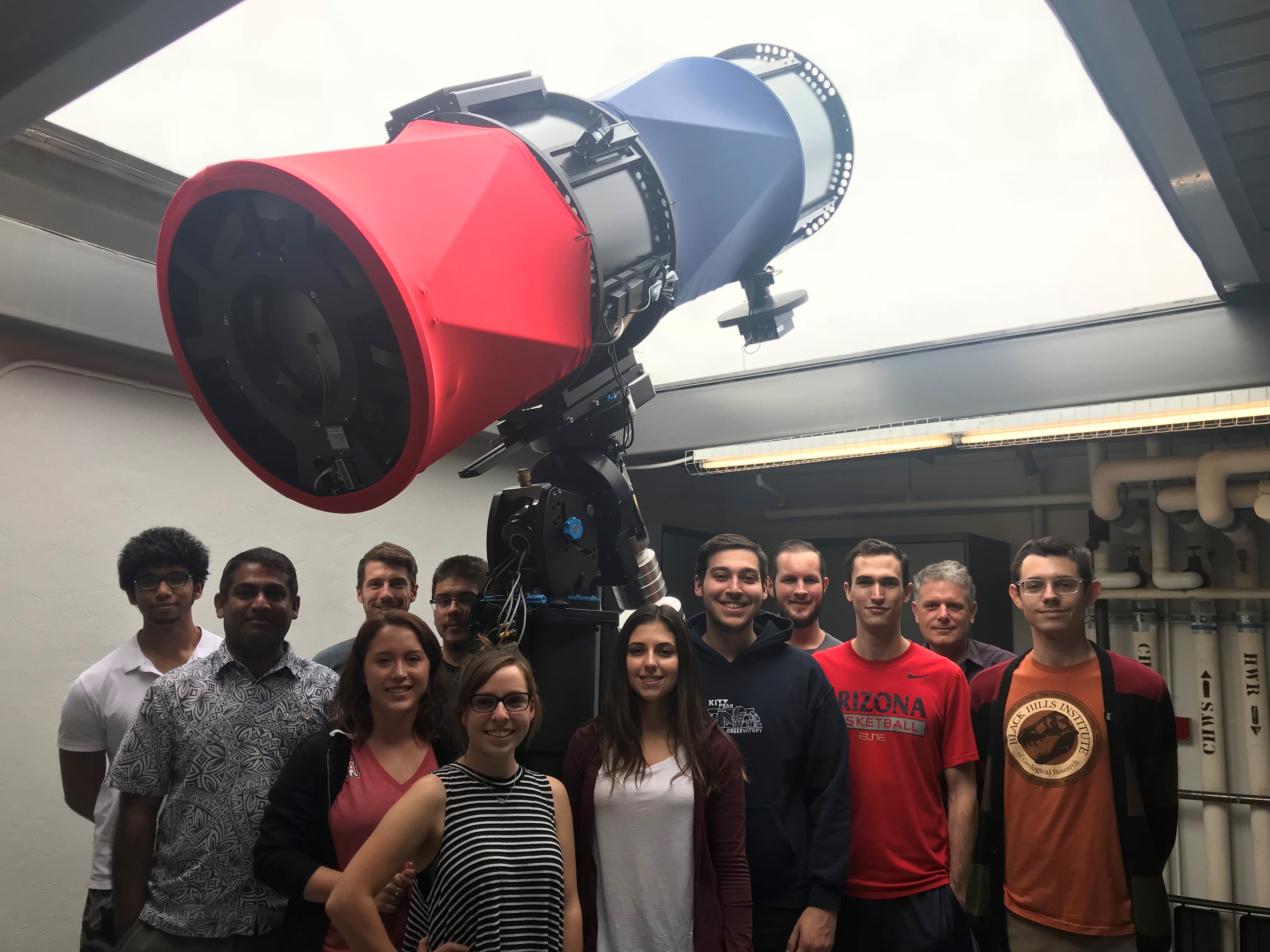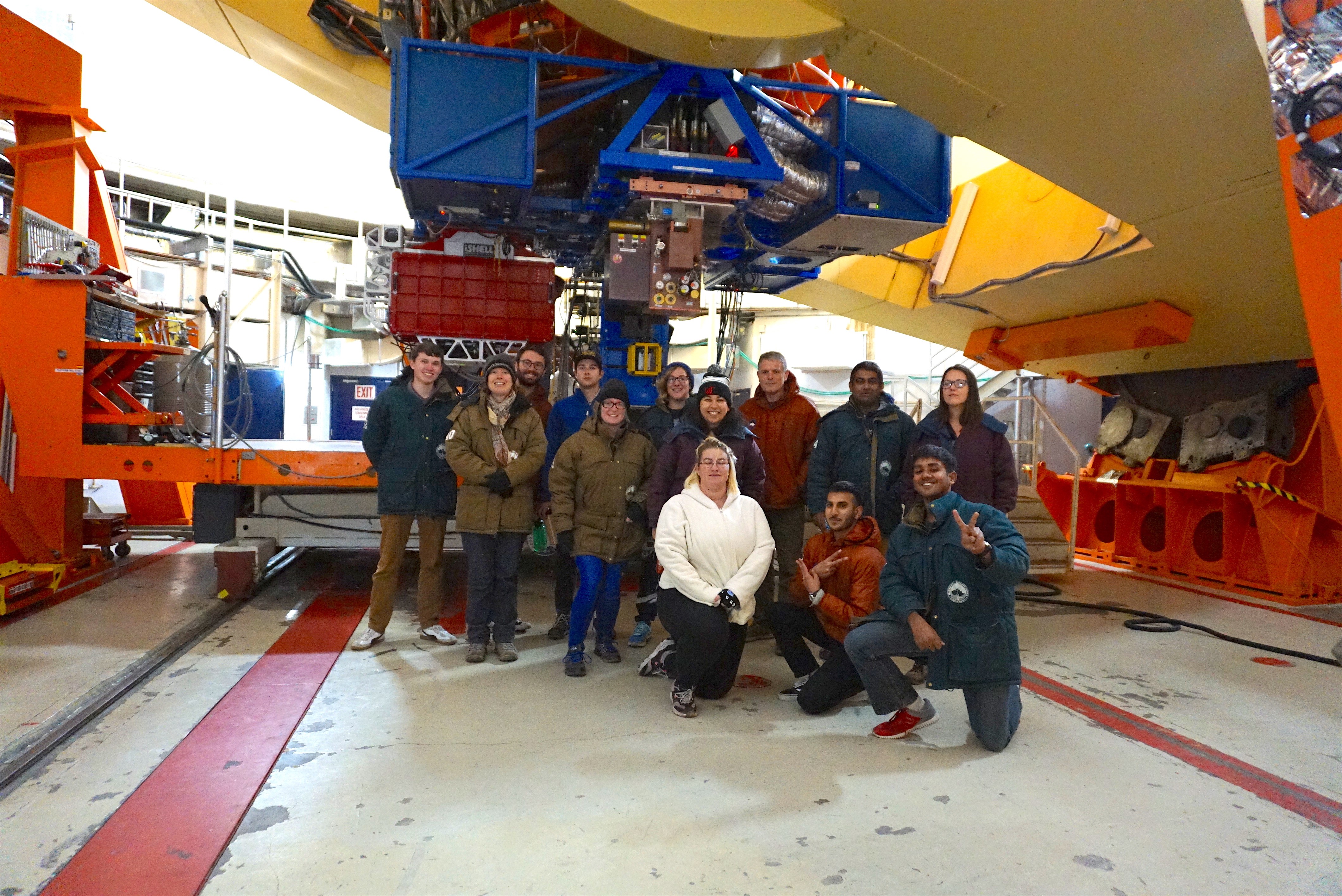PTYS 416/516 and the TC4 Observational Campaign
How would the world respond to the late discovery that an object was on a possible collision course with the Earth? How rapidly could we confirm its orbit to assess the likelihood of a collision and range of locations where it may occur? Could we determine its size, rotation state, and composition in order to quantify the threat posed? Would we have enough time to develop a response on the ground to minimize the threat to life and other assets? Students in this semester's offering of PTYS 416/516 (Asteroids, Comets and Kuiper Belt Objects) had the opportunity to consider these questions and to participate in the TC4 Observational Campaign, a global effort sponsored by the NASA Planetary Defense Coordination Office.
Beginning last July, a global consortium of astronomers began tracking the asteroid 2012 TC4, a small asteroid predicted to have a close encounter with Earth on October 12, 2017. The LPL member of the TC4 project, Assistant Professor Vishnu Reddy, was tasked with obtaining spectral information from TC4 during the close approach period using the NASA IRTF. Recognizing the wider opportunity this event provided, he teamed with Associate Professor Walt Harris, with whom he was co-teaching the 416/516 course, to put together a class project related to this event. For this, the class was divided into two groups with separate responsibilities. The undergraduates in the course were given the task of following TC4 using the new RAPTORS telescope on the roof of the Kuiper Building. The graduate students, accompanied by professors Harris and Reddy, would travel to the big Island of Hawaii, where they would be directly involved in the IRTF observations, a trip underwritten by the LPL External Board of Advisors.
On October 7, the graduate team of 11 students arrived in Hilo, Hawaii, for the IRTF observations. On their way to Mauna Kea, they made a side trip to Volcanoes National Park, where they toured recent lava flows and were treated to a presentation on the ongoing HI-SEAS Mars mission simulation project. They also were given a guided tour of the observing process by Bobby Bus, the Deputy Director of the IRTF. With his help, the students were able to obtain a precursor spectroscopic measurement of TC4 from the remote observing site at the Institute for Astronomy in Hilo. The next day, they began their ascent of Mauna Kea, stopping first at the Hale Pohak–Onizuka center at an altitude of 9200 ft, where they would spend time adapting to reduced oxygen levels before making a "test" ascent to the IRTF at 13675 ft. During the test run, the students toured the telescope and followed along as the operator managed a nightly target list.
For the evening of the scheduled TC4 observations, the group was divided into two shifts. The first shift went to the summit near sunset with Professor Reddy, where they began making calibration observations. Down at Hale Pohaku, Professor Harris was waiting with a second group scheduled to go to the telescope at 8:30 p.m. where they would manage the second half of the observing program. Just as the second team was assembling to head to the summit, Hale Pohaku, along with every telescope on the mountain, was plunged into darkness by a power outage. The students at the summit quickly became involved in the effort to protect the telescope by closing the mirror covers and the dome. Once power was restored (2 hours later), the operators worked furiously to recover the computer control systems, reset control of the telescope, and to restart the focal plane instruments, but were unable to complete these tasks in the small window of opportunity that remained for observing TC4. During this time, the students were active in documenting the steps taken, providing a valuable record of the event.
Back in Tucson, the undergraduate team had assembled in the roof observatory in the Kuiper building to observe TC4. RAPTORS was not formally part of the global effort, and had only been commissioned a few months earlier. However, the student group was well prepared, having completed several nights of test observations looking at other asteroids. Their goal was to acquire TC4 and obtain a sequence of observations to be used for refining its measured 13-minute rotation period. This was a difficult task given the very low brightness of the object and its rapid motion against the background stars, and it meant that real time confirmation of the presence of the asteroid was not possible in every image they took. Working from a targeting ephemeris, they followed the expected location of the asteroid for more than two hours. Subsequent processing of the images they obtained showed that they were able to detect TC4 and track it across the sky.
The project achieved its goals of giving students the opportunity to be involved in a hands-on research project while also obtaining measurements to be used as part of the wider effort to characterize TC4. While the graduate student team was not able to obtain an IRTF spectrum on the night the students were present at the observatory, the data they obtained during remote observations 2 nights earlier meant that they did not return empty handed. They also gained new insight into the challenges and frustrations that come with groundbased observing, and their assistance during the power outage will be useful for optimizing the IRTF recovery process in the future. The undergraduate team had a successful observing run made possible through their own careful preparation, and provided the side benefit of obtaining observations that will prove useful for characterizing the RAPTORS telescope performance. As Haris Niazi, a member of the graduate student team, summed up the entire experience, “It was wonderful being part of something that takes you out of the familiar confines of a classroom and pits you against a real-world research problem. Observing was quite the experience.”



